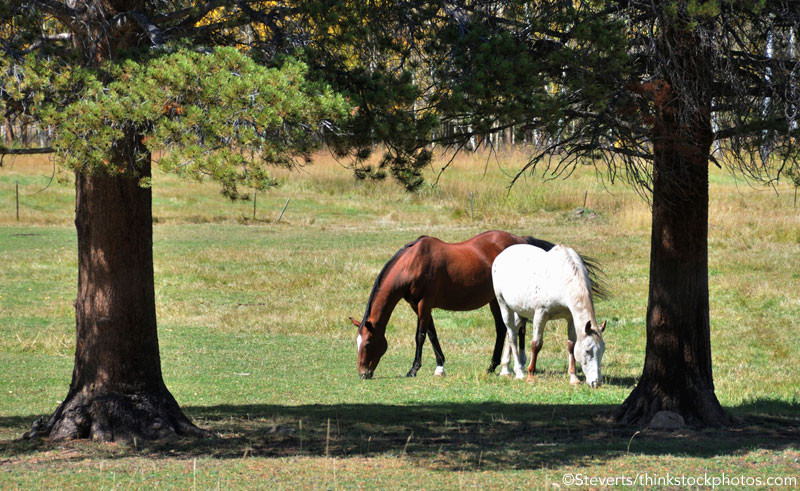
You might not have to bring her in every night, but you still need to check on her every day. It only takes a few seconds for a horse to get seriously hurt and it’s important that someone (your or the barn owner) keeps a regular eye on your four-legged friend.
Here are some important things to remember if your horse lives outside most of the time.
- Your horse needs some sort of shelter in the field. Is there a run-in shed or a tall hedge or trees that can give her some shelter from the wind in wintry weather?
- Check your horse’s legs every day, even if it means wading through knee-deep mud. You need to feel for heat and swelling to make sure that your pony didn’t get into any trouble while you were away.
- Apply equine or human sunscreen liberally to your horse’s face if he’s light colored or has a pink muzzle. Horses that live outside can burn even in the winter if the sun is reflecting off the snow. We all hate being sunburned–make sure your horse is wearing sun block whenever the sun is shining!
- Make sure that your horse is protected from flies and other biting insects in the summer. Apply fly spray to your pony as often as directions allow. If the flies still seem to be bothering him after applying fly spray, consider getting him a fly mask, flysheet or fly leg wraps to make him more comfortable.
- Walk your fence line at least once a week to check that the fencing is safe and secure. You want to make sure that your horse can’t escape, and that there are no loose boards or wires that he could cut himself on. This is also a good time to look for trash that might have blown into the field. Pick up plastic bags and other junk that appears in the field.
- Pick out your horse’s feet every day, even if you’re not going to work him. It is important to make sure there are no sharp stones trapped in his feet that could give him a stone bruise. Ouch!
- Try to pick up piled manure with a pitchfork and wheelbarrow as often as you can. Manure promotes flies and worms. It also damages the grass underneath it. It’s best to remove it out of the pasture, but if you can’t, at least take it away from where your horse spends much of his time (i.e. around the water trough or run-in shed).
- In the spring, check to be sure that no poisonous plants are growing in your horse’s field. You can find out which plants as toxic by going to your local extension agency for information or checking out https://www.extension.purdue.edu/extmedia/ws/ws_37_toxicplants08.pdf, which shows you pictures of the plants.
- If you clip your horse, you must blanket him well in the winter. You don’t want him to catch a chill. Take off his rugs every day so you can give him a once over and make sure that he doesn’t have any rubs or irritation from the blankets. Make sure you fasten all of the straps on the blanket—a loose strap could lead to an accident.
- Check to be sure that the water trough or bucket is filled every day. Try to dump it out completely and rinse the bucket at least once a week. Stagnant water is a prime location for insects to breed, so make sure your horse’s water is clean. Also, in the winter, be sure that there is no ice covering her trough so she can’t drink. You may need to use a trough heater in the water. You can find them in catalogs or at feed stores.
- If there are several horses in the field, be sure to separate their food when feeding them. You wouldn’t want one horse to eat everyone’s food! Spread hay piles at least 15 feet apart and always make one more pile than there are horses, so each horse has something to eat!
- In the winter, keep an eye on your horse’s heels for mud fever, a nasty infection caused by wet, muddy conditions. It’s a good idea to get your horse out of the mud and dry off his legs a couple of times a week to try to prevent mud fever. Dew poisoning is similar problem that usually happens in the spring and summer and is caused by the dew on the grass in the morning. You may need to dry off your horse’s legs every day and apply medication.
- Horses are herd creatures. This means they like equine company. Try not to keep your horse by herself if possible. If you don’t have room for another horse in the field, consider getting a donkey or a goat to keep her company. A donkey or goat will also need some sort of shelter when it gets cold.
- If your horse gets burrs in her mane and tail, it’s best to get them out quickly before they turn into huge knots. Some people recommend using baby oil to work the burrs free from the hair.
- If your horse is easy to catch, turn her out in her pasture without a halter. She’s less likely to get caught on anything and it will be harder for would-be thieves to steal her. If she must wear a halter, put a leather one on her. If a nylon halter gets caught on something it won’t break easily and your horse could break his neck or suffer another injury.
Things that will help you look after a field-kept pony
Human fly spray
Tall rubber boots
Carharts or some other brand of insulated coveralls or overalls
A rain poncho
A warm hat
Waterproof gloves



